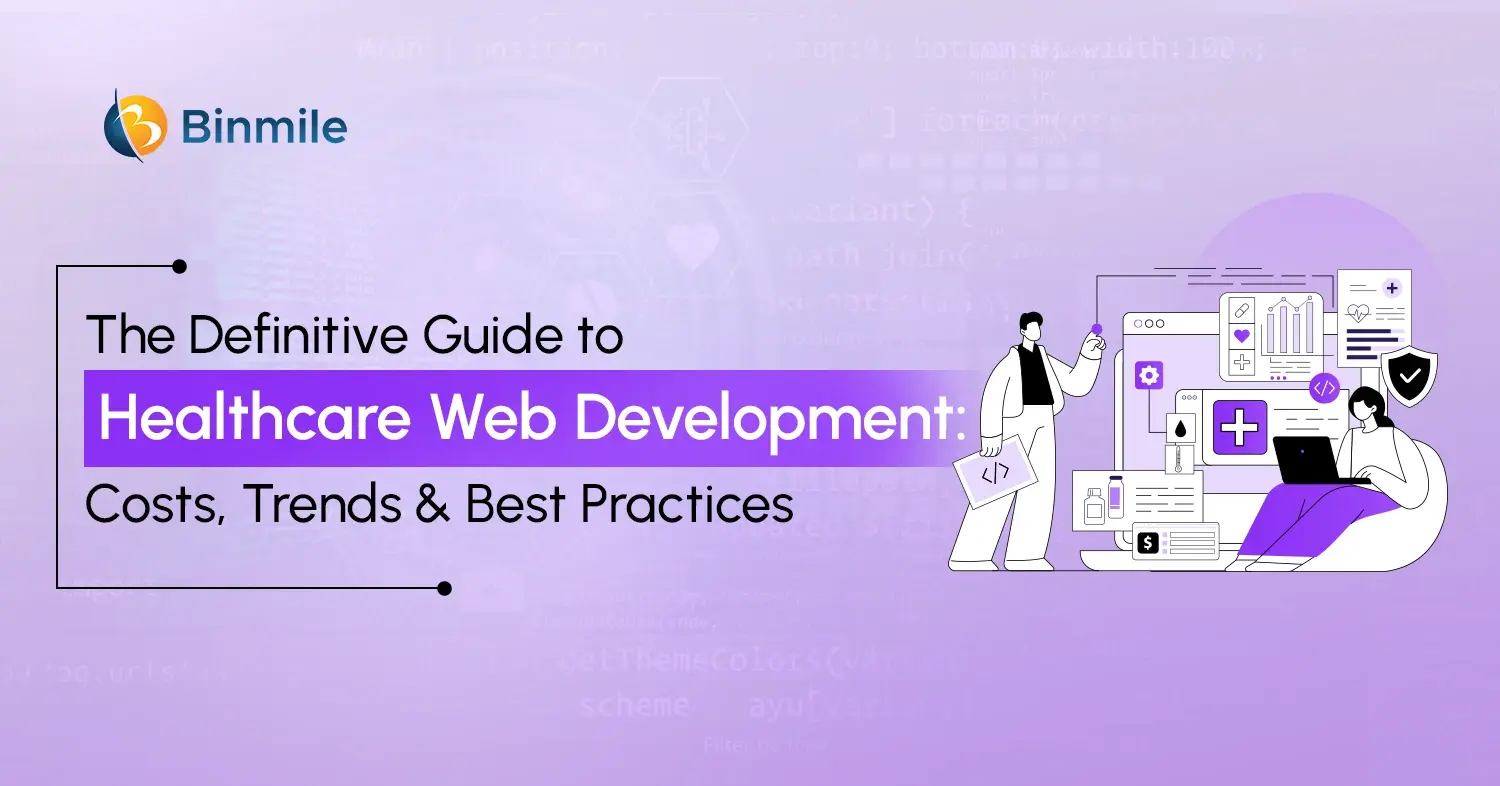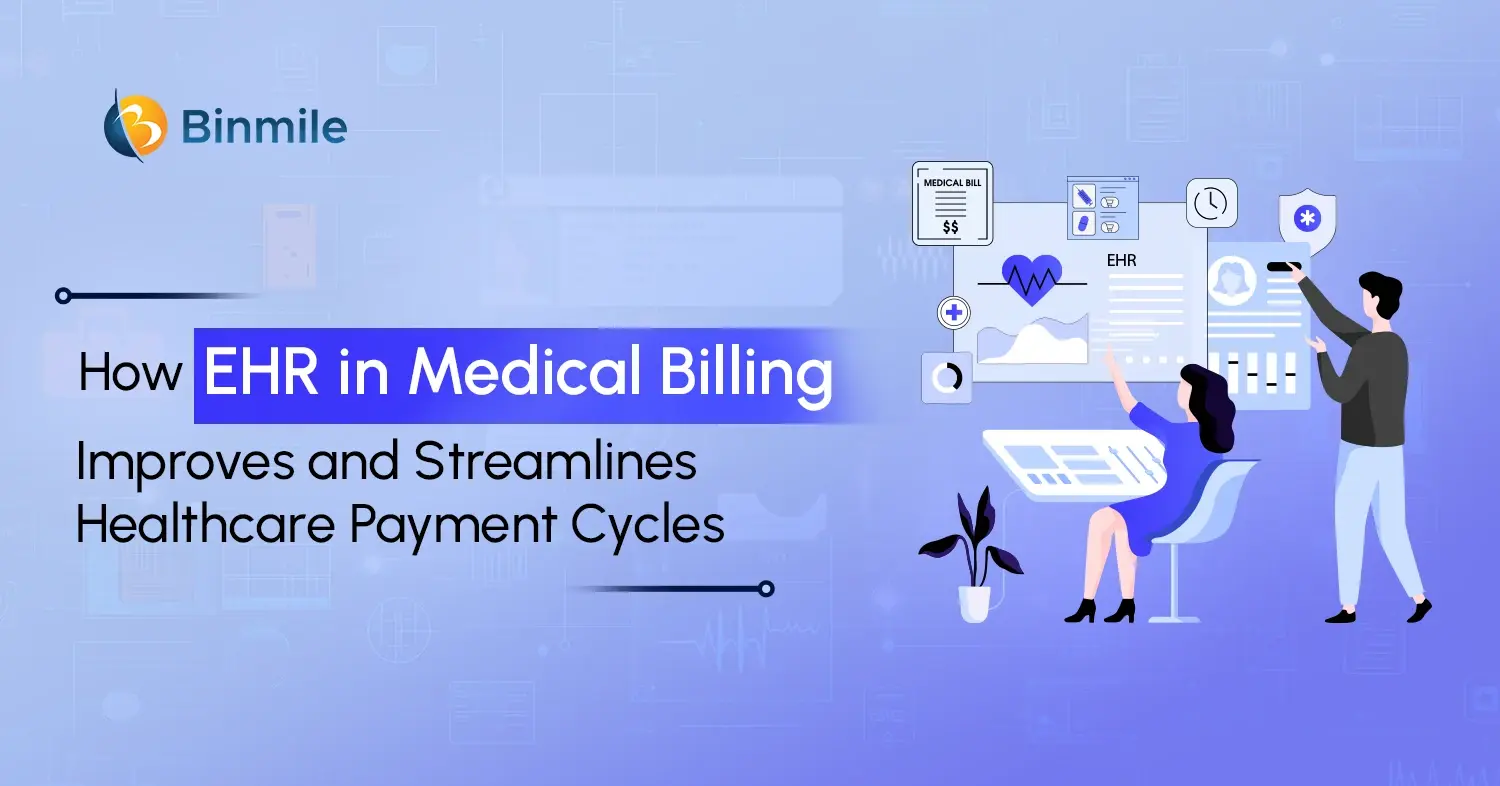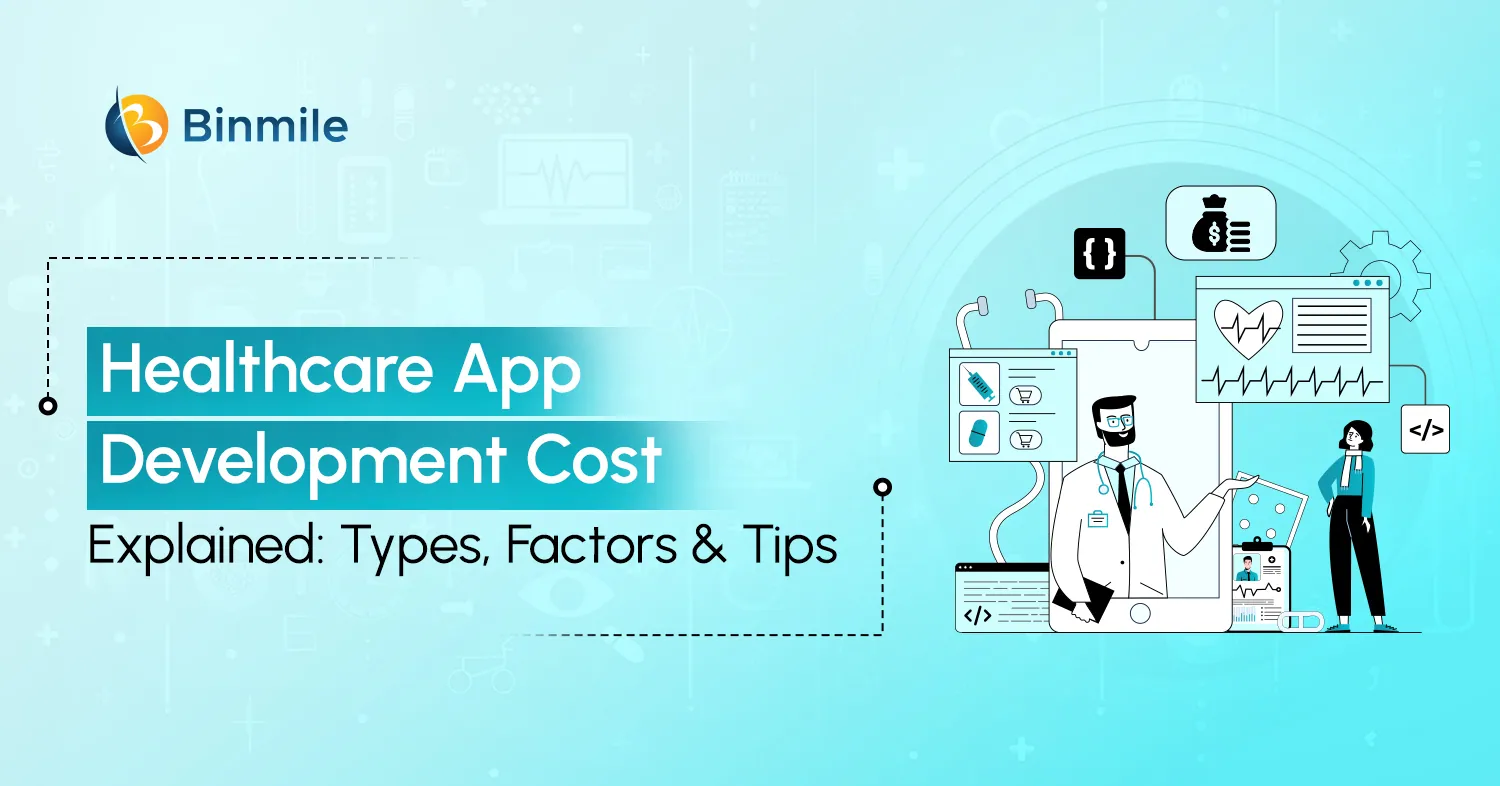- complexity of healthcare web development
- cost of healthcare web development
- factors influence the healthcare software cost
- healthcare web app development process
- Healthcare Web Development guide
- how to design healthcare web app
- How to Perform Healthcare Web Development
- Medical web development
- reasons to build healthcare web app
- Top Healthcare Web Design Trends
With the rising demand from patients or users for convenient and 24/7 access to medical services, healthcare websites have become a crucial part of the healthcare industry. About 70% of the Indian population has used these healthcare websites to avail medication or track symptoms. However, to build a unified healthcare website, businesses need to follow a streamlined development process. With a strategic healthcare web development approach, businesses enable patients to have continuous support for medical consultations or booking appointments without actually visiting the place.
Having a healthcare website is crucial for businesses, as it will help them to increase their user engagement and thus conversions. So, how to build an effective healthcare website? This blog will explore the complete medical web development process, design trends to implement, key factors that influence the cost, and hidden complexity with best practices.
Why Invest in Healthcare Websites: Main Reasons to Know
Before starting the medical website development process, it’s important to know the main reasons for investing in these medical platforms:
1. Get Credibility
Doctors are the most trusted source of medical information for most patients across the globe. Nowadays, patients prefer convenience and want to seek medical advice and services through smartphones or other devices. Therefore, establishing an online presence is necessary, as 47% of internet users look for doctors or other health professionals online. Investing in a healthcare website, businesses can reach out to more potential patients and build trust by showcasing their services and in-depth knowledge.
2. Offer Communication 24/7
Patients may need medical help at any point in time, be it in the middle of the night or early morning. This is common in healthcare industries, as there are no defined business hours. By investing in a healthcare website and availing healthcare software development services, patients can have continuous support to:
- Book an appointment
- Access the medical records or relevant information
- Get consultation services within a few minutes
This results in delivering a 24/7 available healthcare website that results in increased patient loyalty and satisfaction.
3. Reduce Long-Term Costs
Businesses having healthcare websites can leverage automation capabilities on core business operations such as appointment scheduling, manual patient records, communication with patients, etc. This eliminates the need for manually handling and managing these tasks, and thus, teams can focus more on other crucial business activities. With consistent and right implementation of automation, it can lead to reduced consumption of resources and ultimately lower long-term operational expenses. Therefore, investing in a healthcare platform is an overall cost-effective solution.
Healthcare Web Development Process: A Step-by-Step Guide
The healthcare web development process involves 5 strategic end-to-end steps – from the idea origination to the launch and maintenance. Let’s explore these steps in detail:
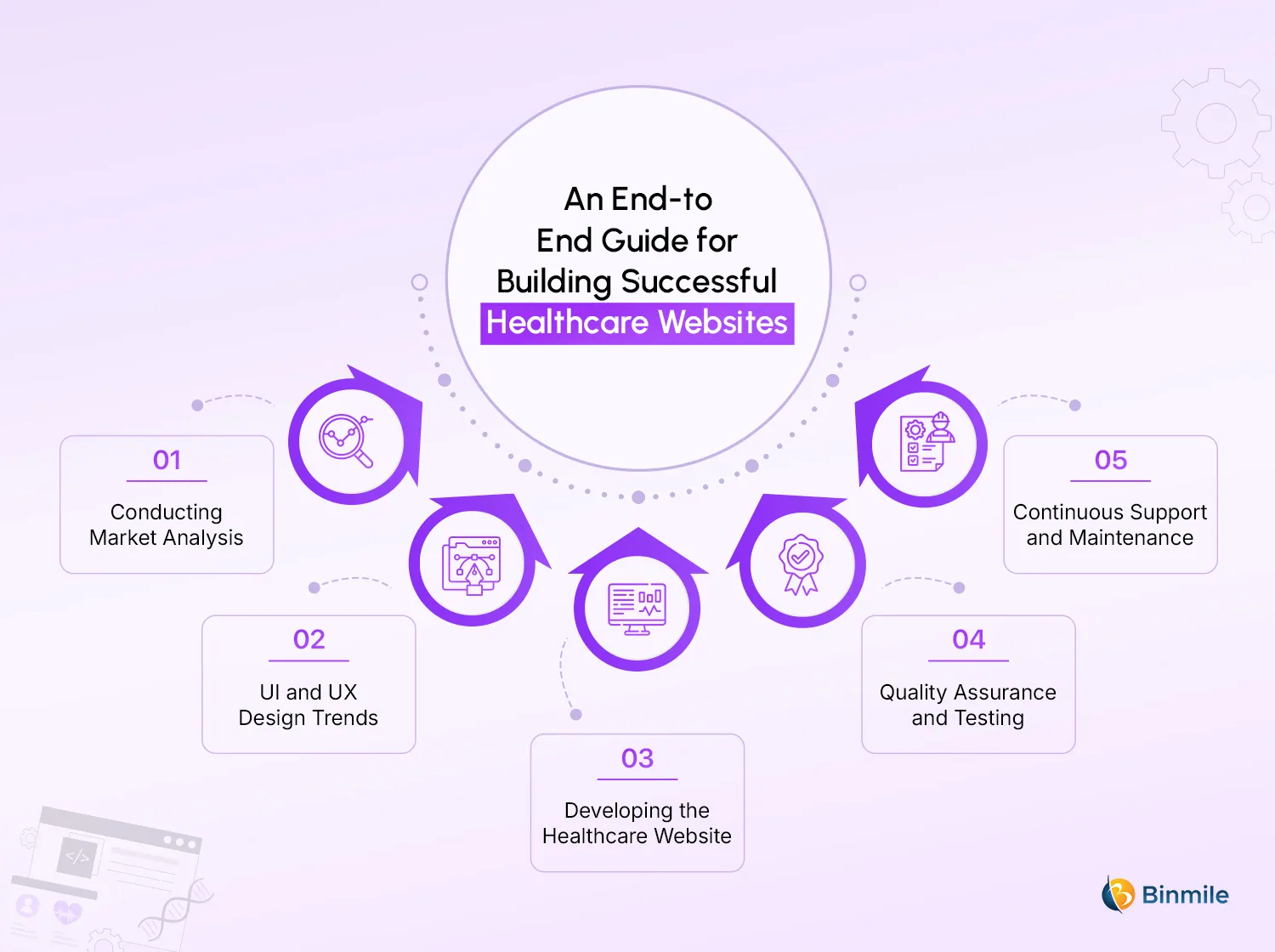
1. Conducting Market Analysis
The medical web development process begins by analyzing the targeted market and businesses needs to assess how their healthcare site will have a competitive advantage in the particular industry. To do so, core stakeholders and the development team need to prepare a comprehensive list of website needs, which will guarantee a positive market fit rate. This will help clear questions like:
- Types of features and modern trends to follow
- Overall estimated cost of medical website development
- Expected delivery timeline of the healthcare website
2. UI and UX Design Trends
After gathering a comprehensive list of what the website will have to offer, the next step is to design the healthcare website. The design of the website matters the most, as a good design, which is appealing and has categories listed in a simplistic way, retains a higher percentage of patients or users. This can be done by utilizing modern UI/UX design trends that help users access healthcare services with much more ease. We’ll be exploring these design trends in the detailed section below.
3. Developing the Healthcare Website
After designing the healthcare website’s wireframes, the next step is to start coding the main logic for building the website. Development teams need to choose the correct tech stack that enables them to build scalable and modern functionalities for the website. This developing procedure mainly comprises 3 phases:
- Frontend Development: In this phase, teams build the user interface of the healthcare website and focus on developing an overall interactive user experience. This is done by creating visual elements that go well with the overall color scheme and text colors. Some of the most widely used frontend frameworks are ReactJS and VueJS.
- Backend Development: The backend development phase involves the process of writing the server-side logic that determines how the website’s elements will behave and react while a user interacts with it. It also helps in storing, updating, and managing data by integrating it with a database. It handles and processes the user request by using APIs and maintains seamless communication with the UI of the website. Popular backend languages are Python and Java.
- System Integration: After building the healthcare website, businesses must integrate it smoothly within their existing medical systems, such as hospital management systems or any other telemedicine platforms. By utilizing third-party APIs that are secure, businesses can ensure that there is complete transparent communication happening between the healthcare site and other medical systems.
4. Quality Assurance and Testing
After the integration phase, teams need to perform various testing phases, solving any bugs, if there are any. End-to-end testing phases include acceptance testing, security testing, load testing, and other relevant phases and help in making the website secure to use.
Moreover, healthcare websites are also checked for HIPAA (Health Insurance Portability and Accountability Act) compliance requirements and the rest of the relevant regulations. After the testing is done, businesses can ensure that there will be no bugs, and they can launch their healthcare website in the targeted market.
5. Continuous Support and Maintenance
After the launch of the healthcare website, businesses should provide support and maintenance services if required. They should also make sure that the website remains available for maximum usage. The maintenance phase also carries out continuous improvement to ensure the long-term viability of the website. This can be done by adding new and modern features and also improving the UI/UX design.
Top 5 Healthcare Design Trends to Watch
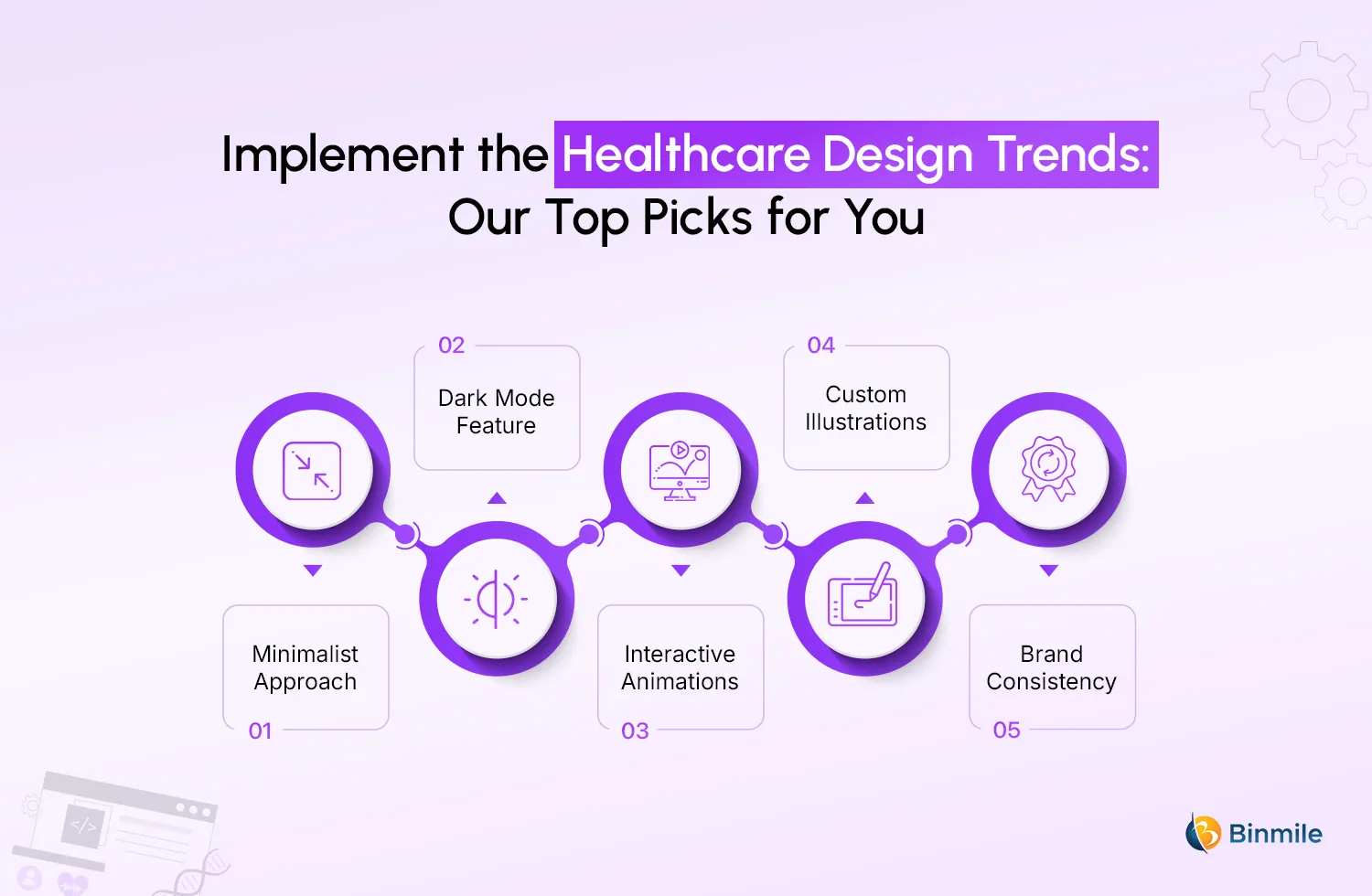
1: Minimalist Approach
Healthcare websites designed with a minimalistic approach help patients navigate the site thoroughly with ease and calm. In this approach, design teams create the website in a clear and organized way. To do so, they use simple color schemes and fonts, which are appealing and provide a smoother user experience.
Moreover, for a clutter-free design approach that comes with simple layouts and clear headings, teams can improve accessibility by reducing distractions on the page. This is beneficial for users, especially those who have cognitive disabilities.
2: Dark Mode Feature
Adding the dark mode feature while designing the healthcare site is beneficial, as it reduces eye strain by providing a low-light screen. Development teams can add customizable settings to the website codebase to give control to users about how they want to see the overall website layout. For example, they can create two themes- A light and Dark theme and users can browse easily by choosing their preferred theme.
In addition to the smooth theme transitions, design teams need to create high contrast for text in order to keep the readability as it is in the dark theme. This approach improves inclusivity and enhances accessibility for users who have any type of visual sensitivities.
3: Interactive Animations
Healthcare websites should incorporate some interactive animations or motion graphics to make the whole user experience a lot more engaging. These animations should be informative as well as sleek and simple to understand. Design teams can create animated dashboards or charts, hover effects, loading indicators, etc.
The main page can have an entrance animation whenever a user reloads the healthcare page. These animations should be implemented in a way that doesn’t cause any distractions or anxiety to the patients and instead should improve accessibility and navigation.
4: Custom Illustrations
Healthcare website design should be unique and have a personal touch that helps represent the website and its specific services in the targeted competitive market. For this to happen, designers or design teams create high-quality and consistent illustration templates that help users simplify the medical concepts behind the services the business is offering.
The custom illustrations should perfectly align with the services the brand is offering and also match the overall color scheme of the healthcare site. When the custom illustrations are ready to use, development teams can integrate them into the main website’s design for an appealing view.
5: Brand Consistency
The healthcare website should have a consistent brand identity to extend a sense of reliability and trust. To make the healthcare brand consistent, design teams can design standard template guidelines that have a list of colors, fonts, and visuals to be used.
After the guidelines are ready to use, developers can now implement the main logic with consistent use of the guidelines. A customized healthcare website, which has an overall consistent design, ensures that the users have a lasting impression, thus leading to more engagement with the brand’s services.
Cost Estimates for Developing a Healthcare Website: Key Factors That Influence
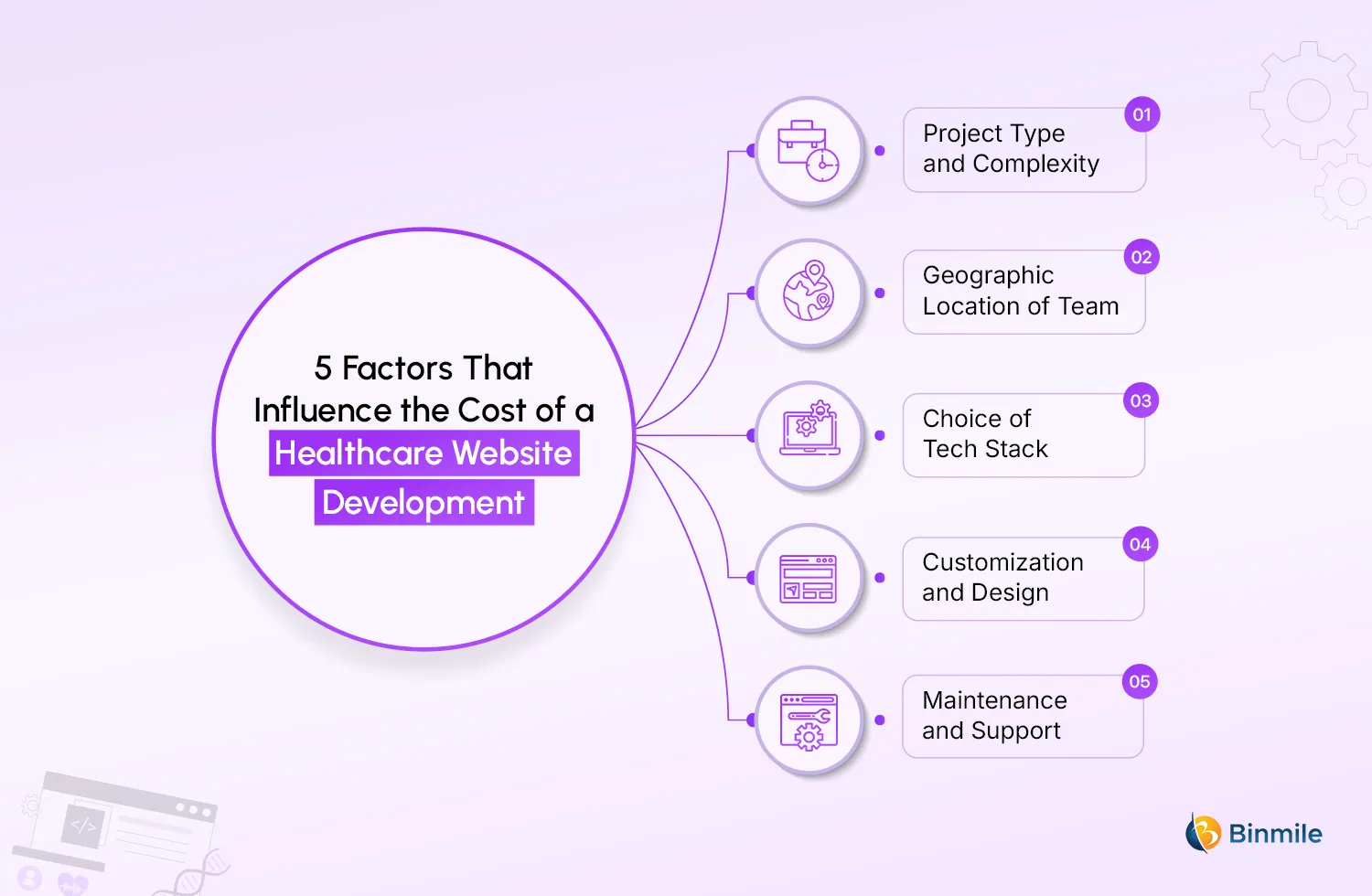
1. Project Type and Complexity
The larger and more complex the type of healthcare web development is, the higher the development costs and other expenses will be. This is because the large-scale website comes with multiple user roles, advanced security integrations, and real-time analytics and monitoring capabilities, which increase the costs and require more team efforts.
These are the cost estimates based on the complexity and type of healthcare Website:
| Healthcare Website Type | Main Features | Cost (in approx.) | Development Time |
|---|---|---|---|
| Basic Version |
|
$15,000 – $50,000 | 1 – 3 months |
| Medium Version |
|
$50,000 – $150,000 | 3 – 6 months |
| Enterprise-grade Version |
|
$150,000 – $200,000, or more | 6 months or more |
2. Geographic Location of Team
The geographic location of the developer or the team plays an important role in deciding the healthcare website cost. Developers or teams that have higher living costs and their demand in the market usually charge more than the others, which have low living costs and less demand.
| Country | Average Cost (Hourly-basis) |
|---|---|
| India | $15 – $25 |
| Mexico | $25 – $49 |
| Poland | $25 – $55 |
| Ukraine | $35 – $60 |
| United Kingdom | $100 – $150 |
| USA | $100 – $200 |
These are the cost estimates based on the location of the developer who will work on the healthcare website development process.
3. Choice of Development Technology
Another factor that is very important to consider is the choice of technology used in the development phase. Availing widely used ReactJS development services, Python development services, and other cost-effective languages has relatively lower development costs than the cutting-edge and modern technologies such as blockchain, AI/ML, RPA, cloud computing, etc.
These are the cost estimates based on the type of technology utilized to build the healthcare website:
| Technology Type | Developer Salary (Monthly basis) |
|---|---|
| ReactJS (Frontend) | $2,500 – $7,500 |
| Python (Backend) | $3,000 – $9,000 |
| Node.js (Backend) | $3,000 – $7,500 |
| Ruby on Rails (Backend) | $3,000 – $8,000 |
| AI/ML | $10,500 – $20,000 |
| Blockchain | $11,000 – $20,000 |
| Cloud Computing | $10,500 – $20,000+ |
4. Customization and Design
Design and customization of the healthcare site are crucial factors that can influence the overall Total Cost of Ownership (TCO). Businesses leveraging highly customized designs that come with animation widgets, unique portable layouts, or pre-built design components can be costly. However, standard design templates are affordable and cost-effective options while designing the website’s interface.
These are the cost estimates based on the type of customization features opted for:
| Customization Feature | Approximate Cost (in USD) |
|---|---|
| Basic Color Theme | $3,000 – $10,000 |
| Advanced UI/UX Elements | $5,000 – $10,500 |
| Interactive Animation Widgets | $15,000 – $50,000 |
| Pre-built Design Components | $10,000 – $20,000 |
| Responsive and Portable Layouts | $15,000 – $25,000, or more |
5. Maintenance and Support
Another factor to determine the healthcare website cost is the type of continuous support and maintenance services included in the healthcare website development plan. Cost depends on the type of maintenance or support version chosen. Basic maintenance version includes performance testing and fixing the vulnerabilities or bugs, while the advanced version includes a well-planned disaster recovery and real-time monitoring capabilities.
These are the cost estimates based on the type of support version and services included in that:
| Support Version | Maintenance Services | Annual Expenses |
|---|---|---|
| Basic Type | Regular updates, minor bug fixes, durability and performance testing | $5,000 – $15,000 |
| Moderate Type | Security upgrades, functionality or feature advancements, storage backups | $20,000 – $55,000 |
| Advanced Type | Advanced security updates, real-time monitoring 24/7, recovery plans | $60,000 – $100,000+ |
Complexities and Best Practices to Implement While Building a Healthcare Website
While building a healthcare website that is user-friendly and patients can access conveniently, businesses often face challenges that can lead to negative impacts on the business and can come with costly fixes. This is why businesses need to understand these challenges and how to counter them with best practices:
1: Security for Sensitive Medical Data
Healthcare websites store sensitive medical records that are confidential. If the site is not secured enough and any minor vulnerability occurs, then it can lead to severe damage to the brand’s reputation as well as financial losses if customer abandonment occurs due to this.
Solution: The healthcare website should include advanced security features such as multi-factor authentication, user control, data encryption, biometric authentication, etc. Also, regular security auditing should be implemented to detect any unnecessary activities that are going on before they end up in a threat.
2: Compliance with Healthcare Legal Regulations
Healthcare websites need to comply with healthcare-industry-related regulations such as HIPAA (for the US) or GDPR (for the EU) or any country-specific regulatory body, which depends on the country the healthcare website will be launched in. Not complying with any of the laws and regulations, businesses can incur heavy fines, and also the brand’s image can be tarnished.
Solution: Regular compliance should be implemented while the development process is occurring, not after that. It can be achieved by designing and coding the logic of the healthcare site, which is more aligned with the regulations and necessary requirements.
3: Integration with Existing Medical Systems
The healthcare website needs to rely on outdated Electronic Health Record (EHR) or Electronic Medical Record (EMR) systems, which sometimes lead to compatibility issues, as these old systems can have a slower performance or lack modern APIs. This can result in delays or ineffective communication between the two.
Solution: Teams can utilize some middleware platforms, such as Redox, Healthshare, etc., which can help provide real-time synchronization and smooth integration between healthcare websites and old EHR/EMR systems.
Last Thoughts on Healthcare Web Development
With an effective and right healthcare web development approach, businesses can provide a reliable experience to their patients. It is beneficial for businesses, as using a healthcare website, they can save manual efforts and resources, which results in reduced long-term operational costs.
However, to have a manageable healthcare platform, businesses need to evaluate their unique goals and then implement them in such a way that the goals are aligned with the development process. We hope that this blog helped you in understanding the practical healthcare website development process, the cost behind building it, and the complexities that you can encounter. If you still have any questions or want to have a correct development roadmap, partner with an experienced app development company.
Frequently Asked Questions
Medical web development involves creating digital platforms, such as websites and applications, specifically tailored for the medical and healthcare industry. These solutions enhance patient engagement, streamline administrative tasks, and offer a secure means for healthcare providers to interact with patients online.
Medical web development enables healthcare providers to offer streamlined services, including appointment scheduling, online consultations, and patient records management. A well-developed platform can improve patient experience, reduce administrative workload, and increase the accessibility of healthcare services.
Some key challenges include ensuring regulatory compliance (e.g., HIPAA in the U.S.), managing data security, handling large volumes of sensitive information, and creating an intuitive, user-friendly interface for all users.
Healthcare web development enables providers to offer accessible, user-friendly, and efficient digital services to patients. A well-designed healthcare website can enhance patient experience, streamline appointment scheduling, facilitate patient education, and improve overall engagement.
